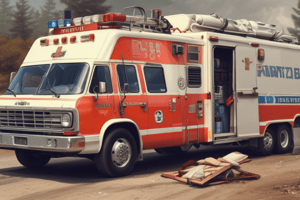Podcast
Questions and Answers
What is the primary cause of hyperventilation?
What is the primary cause of hyperventilation?
- Lowered carbon dioxide level in the blood due to heavy breathing (correct)
- Higher carbon dioxide level in the blood due to shallow breathing
- Increased heart rate due to physical activity
- Decreased oxygen level in the blood due to high altitude
What should you do if a passenger experiencing hyperventilation does not respond to calming measures?
What should you do if a passenger experiencing hyperventilation does not respond to calming measures?
- Call for medical assistance immediately (correct)
- Administer high-flow oxygen
- Have them breathe through a paper bag
- Do nothing and wait for it to pass
What are common symptoms of shock?
What are common symptoms of shock?
- Headache, fatigue, and sore throat
- Blurred vision, dizziness, and rapid breathing
- Redness of the skin, feeling hot, and increased heart rate
- Pale or ashen gray skin, feeling clammy, and nausea (correct)
What should you do if a passenger is fainting?
What should you do if a passenger is fainting?
Why is it essential to administer high-flow oxygen to an unconscious passenger?
Why is it essential to administer high-flow oxygen to an unconscious passenger?
What should you do if a passenger vomits while unconscious?
What should you do if a passenger vomits while unconscious?
What is the first action to take when a victim is having an asthma attack?
What is the first action to take when a victim is having an asthma attack?
What may trigger a cardiac emergency?
What may trigger a cardiac emergency?
What is the first step in treating a passenger experiencing a medical emergency?
What is the first step in treating a passenger experiencing a medical emergency?
What are the symptoms of cardiac emergencies?
What are the symptoms of cardiac emergencies?
What should you do if a passenger is experiencing distorted vision and nausea?
What should you do if a passenger is experiencing distorted vision and nausea?
What should you do when assisting a victim with an inhaler?
What should you do when assisting a victim with an inhaler?
What is the correct way to provide oxygen in an emergency?
What is the correct way to provide oxygen in an emergency?
What should you do when a victim becomes unconscious?
What should you do when a victim becomes unconscious?
What is the recommended first aid treatment for fainting?
What is the recommended first aid treatment for fainting?
What is a common cause of hyperventilation?
What is a common cause of hyperventilation?
What is the first step in treating a person in shock?
What is the first step in treating a person in shock?
What is a common symptom of shock?
What is a common symptom of shock?
Why should you not elevate the legs of a person who has fainted?
Why should you not elevate the legs of a person who has fainted?
What is a common cause of respiratory difficulty?
What is a common cause of respiratory difficulty?
When should you provide high flow oxygen to a person?
When should you provide high flow oxygen to a person?
What should you do if a person is bleeding severely?
What should you do if a person is bleeding severely?
What is a symptom of respiratory difficulty?
What is a symptom of respiratory difficulty?
What should you do if a person is experiencing shortness of breath?
What should you do if a person is experiencing shortness of breath?
Flashcards are hidden until you start studying
Study Notes
Fainting
- Brief loss of consciousness, skin may appear pale or ashen gray, and feel cool and clammy.
- Action: Contact STAT-MD, position passenger on back and elevate feet, open airway, and administer high flow oxygen.
Hyperventilation
- Carbon dioxide level of blood is lowered due to heavy breathing, often a result of fear or anxiety.
- Symptoms: numbness or tingling in fingertips and toes, confusion or dizziness.
- Action: Contact STAT-MD, calm and reassure victim, slow passenger's breathing by talking to him/her.
Asthma Attack
- Can be triggered by a reaction to food, medications, pollen, or insect stings, or brought on by emotional distress or physical activity.
- Symptoms: victim may complain of tightness in chest area, wheezing.
- Action: Contact STAT-MD, ask victim if they have an inhaler, provide oxygen, and continue to maintain open airway.
Cardiac Emergencies
- Chest pain, usually in the center of the chest, develops when heart needs more oxygen.
- Symptoms: skin may appear pale, cool, and clammy.
- Action: Contact STAT-MD, administer high flow oxygen, ask passenger if they have medication (Nitroglycerin Tablets), and seek out medical assistance.
Shock
- Symptoms: cold, clammy skin, pale, bluish skin color, weakness, restlessness, rapid/shallow breathing, low blood pressure, and dry mouth.
- Action: Contact STAT-MD, provide high flow oxygen, have victim lie down with legs slightly elevated, and maintain body temperature.
Respiratory Difficulty
- Symptoms: shortness of breath, labored, rapid breathing, unusual breathing (wheezing), blue or gray color to lips or skin, restlessness, and confusion.
- Action: Contact STAT-MD, maintain open airway, provide high flow oxygen, and have victim stay in sitting position.
Bleeding
- Symptoms: minor bleeding, surface wounds.
- Action: Contact STAT-MD, obtain gloves, control bleeding with direct pressure.
Studying That Suits You
Use AI to generate personalized quizzes and flashcards to suit your learning preferences.




